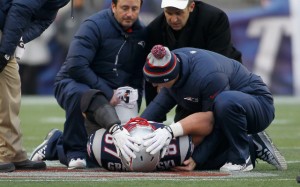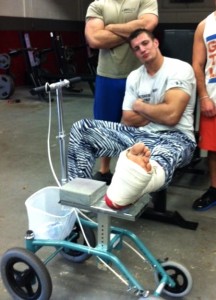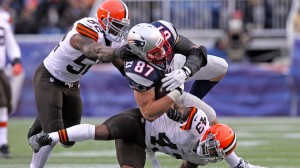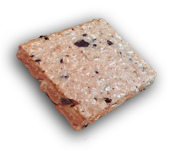 Let me start by saying that I love Football. As an immigrant to this country, I was only truly exposed to the NFL when I moved to the USA in 2005. Took a little while to fully understand the nuances of the game, but once I got that down, I fell in love. Football is a spectacular sport that is both an entertaining and exciting spectacle, but it is also violent.
Let me start by saying that I love Football. As an immigrant to this country, I was only truly exposed to the NFL when I moved to the USA in 2005. Took a little while to fully understand the nuances of the game, but once I got that down, I fell in love. Football is a spectacular sport that is both an entertaining and exciting spectacle, but it is also violent.
I understand that football is a “collision” or contact sport and thus is inherently dangerous. I grew up watching and playing Rugby in South Africa. Like Football, Rugby is contact sport and thus includes elements of violence; however, it seems the violence is far more controlled. I believe this to be because Rugby seems to be more of a tackle-oriented rather than collision-oriented sport. I will explain this shortly.
Anyone who follows the NFL, and even those that do not, are aware of the massive safety initiative the NFL has been rolling out in order to improve player safety, via preventing head hits and concussions. The NFL’s motive is to thwart another lawsuit like the one they paid out to former players in early 2013.
Over the last three seasons the NFL’s Competition Committee has added several new rules in an attempt to minimize the risk of concussions, and thus make the game safer.
• Rule 12 Section 2 Article 8 Prohibits a runner or tackler from initiating forcible contact with the crown of the helmet outside the tackle box.
• Rule 12. Section 2. Article 6: Defines the following as Unnecessary Roughness.
9. using any part of a player’s helmet (including the top/crown and forehead/hairline parts) or facemask to butt, spear, or ram an opponent violently or unnecessarily;
10. (j) grabbing a helmet opening of an opponent and forcibly twisting, turning, or pulling his head.
• Rule 12. Section 2. Article 12. Flagrant striking, kicking, or kneeing an opponent or striking him on head or neck with heel, back or side of hand, wrist, elbow, or forearm
2013 OFFICIAL PLAYING RULES OF THE NATIONAL FOOTBALL LEAGUE
The new rules seem like a GREAT idea in theory: essentially eliminate hits to the head and using the helmet as a weapon. While we await official statistics for the 2013/2014 season, it appears that the head hits and concussions may have decreased slightly this season. Unfortunately, lower leg injuries are on the rise, especially knee injuries. While we haven’t stats for the full season, as of early December, at least 41 NFL players have had season-ending knee injuries this season, an increase of 64% since 2011!
 I admit what prompted this blog was the ACL and MCL tears inflicted upon New England Patriots Tight End Rob Gronkowski in the game against Cleveland. (Yes, having briefly worked with Tom Brady in 2006 offseason, I’m a Pats fan!) Safety T.J. Ward aimed at Gronkowski’s knee as opposed to higher up to avoid the penalty and league mandated fine for hitting the head of the receiver. Ward confirmed this in a post game interview, as well as adding that those types of low hits are all that defensive players are able to do within the NFL’s new rules policy:
I admit what prompted this blog was the ACL and MCL tears inflicted upon New England Patriots Tight End Rob Gronkowski in the game against Cleveland. (Yes, having briefly worked with Tom Brady in 2006 offseason, I’m a Pats fan!) Safety T.J. Ward aimed at Gronkowski’s knee as opposed to higher up to avoid the penalty and league mandated fine for hitting the head of the receiver. Ward confirmed this in a post game interview, as well as adding that those types of low hits are all that defensive players are able to do within the NFL’s new rules policy:
 “If I would’ve hit him up high, there’s a chance I was going to get a fine. It’s kind of being caught between a rock and a hard place. It’s a decision you have to make, but you have to follow the rules at the same time. When they set the rule, everyone knew what was going to happen. This can happen if you have those types of situations. It’s pretty much inevitable, and they forced our hand with this one.”
“If I would’ve hit him up high, there’s a chance I was going to get a fine. It’s kind of being caught between a rock and a hard place. It’s a decision you have to make, but you have to follow the rules at the same time. When they set the rule, everyone knew what was going to happen. This can happen if you have those types of situations. It’s pretty much inevitable, and they forced our hand with this one.”
Click link to see video of Ward’s fully legal hit that ended Gronk’s season.
I see Ward’s point, if a defensive player knows he will be penalized (hurting the team) and fined (hurting his wallet) for hitting high. What choice does he have but to aim low? Plus, Ward’s no stranger to the league mandated fines for illegal hits: he was fined $15,000 in 2010 for a helmet-to-helmet hit on then-Bengals receiver Jordan Shipley, and $25,000 last year for leading with his shoulder while hitting Cowboys receiver Kevin Ogler.

Clearly, this risks injuring players’ knees. Many NFL players have voiced their concerns about this and have stated that they would much rather risk a concussion than an ACL tear. For example, in a Sports Illustrated interview, Miami Dolphin’s Wide Receiver Brian Hartline said, “I would much rather have a bang-bang hit to my head than have someone dive at my knee. I’d be surprised if other players thought otherwise.”
It seems like the players are stuck in a catch-22 as are the NFL who can’t risk another multi-million dollar lawsuit. No doubt the NFL Rules Committee will examine this situation again during the offseason and at owners meetings; however, I’m NOT sure they will look at it the right way. I’m sure some will propose the easiest way to make the NFL safer isn’t to change the way the game is played, but instead to examine changing the required safety-wear. Another helmet redesign? Maybe improved knee padding or protective strips alongside knee, albeit the awkwardness would likely reduce flexibility and range of motion, affecting each player’s gate and speed.
Instead of adding further to the league required safety wear, I suggest the NFL ditch the helmets in favor of a soft skull cap like those worn by Rugby players internationally. In my experience both playing Rugby in my youth and working with the South African pro team, the Springboks during my Masters, I observed far fewer concussions and severe knee injuries than I’ve seen in my years as an American Football fan. Many will say this is crazy and that head injuries will increase exponentially. However, statistics seem to state the opposite. In 2012 the NFL concussion rate was reported at 0.68 concussions per game, whereas the International Rugby Board reports a mere 0.16 concussions per professional game. Do the math, concussions occur 4.25 times more frequently in Football, the sport requiring players wear hard helmets to protect their heads!
 You may ask, how is this the case? It’s actually quite simple to those that have played Rugby: without a helmet, each player is far more concerned about his own safety when making a tackle. The helmets and massive shoulder pads in Football give players sense of omnipotence when it comes to making a hit. They aren’t concerned for their own wellbeing, and thus fly fearlessly into tackles, often using the helmet as a weapon to inflict damage on the recipient. Football teaches players merely try to hit as hard as possible with the head/shoulders. A more effective technique would be training a player to actually wrap arms around an opponent and bring him down. In Rugby, proper tackling technique is ingrained into juvenile players at an early age:
You may ask, how is this the case? It’s actually quite simple to those that have played Rugby: without a helmet, each player is far more concerned about his own safety when making a tackle. The helmets and massive shoulder pads in Football give players sense of omnipotence when it comes to making a hit. They aren’t concerned for their own wellbeing, and thus fly fearlessly into tackles, often using the helmet as a weapon to inflict damage on the recipient. Football teaches players merely try to hit as hard as possible with the head/shoulders. A more effective technique would be training a player to actually wrap arms around an opponent and bring him down. In Rugby, proper tackling technique is ingrained into juvenile players at an early age:
1) Aim for the hips
2) Get your head to the side of the opponents’ body
3) Lead with your shoulder to protect your head
4) Wrap up with your arms
5) Bring the player down
These principles teach Rugby players how to protect their heads as well as how to tackle your opponent with out injuring him.
Don’t misunderstand what I’m saying. I’m not suggesting that from the start of the 2014/2015 season NFL and NCAA Football be played without helmets. These changes can’t be made so suddenly at the professional and collegiate levels. Players need to be given time to adapt at that level of the sport. I suggest that in early levels of football such as peewee and high school these changes be made quickly, if not immediately. For the NCAA and NFL I would propose the following:
2014: All helmets restricted to 2 simple bars on the facemask.
2015: All helmets restricted to 1 single bar on the facemask as well as reduced shoulder pads.
2016: All helmets eliminate the facemask all together and transition to softer shoulder pads.
2017: Transition to soft skullcap.
Transitioning gradually, this will allow the players to adapt to how they hit and to improve tackling technique.
For those of you worried about he impact it will have on the game and the fact that there will no longer be “big hits” in football that fans love to see, I say not true. Rugby still has many “big hits” and ferocious tackles, just safer ones.
The simple, and sad, fact is that unless the NFL finds a way to truly make the game safer, we may be seeing the last generation or two of Football. The latest statistics show that each year increasingly fewer kids are signing up to play youth football (ESPN Outside the Lines notes a 9.5% drop between 2010-2012). Many American parents motivated by safety concerns choose to sign their kiddos up for less violent sports, like soccer. As radical as it may seem, I firmly believe losing the helmet, can actually motivate players to make more effective tackles, reducing frequency of both concussion and severe knee injuries. Making Football a safer sport will prolong it as an enduring aspect of American culture.
Sources:
Boston Globe http://www.bostonglobe.com/sports/2013/12/09/browns-safety-ward-low-options-hit-that-hurt-patriots-rob-gronkowski/hoymJn5FgDur6A844JZHsM/story.html
NFL.com http://www.nfl.com/videos/nfl-game-highlights/0ap2000000294204/Rob-Gronkowski-carted-off-field
Sporting News NFL Injury List http://www.sportingnews.com/nfl/injuries
Bloomberg http://mobile.bloomberg.com/news/2013-12-09/gronkowski-spotlights-nfl-s-60-surge-in-knee-injuries-from-2011.html
Rugby Union https://www.youtube.com/watchv=FWILREWptvs
NFL Official Rules https://www.nfl.info/download/2012MediaGuides/2013%20NFL%20Rule%20Book.pdf











